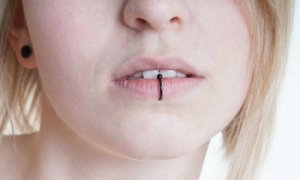Body Piercings for Teenagers: Are They Advisable?

Body piercings are very fashionable among teenagers these days. Both girls and boys use them to attract those around them, and even to rebel in some way against their parents.
They tend to have them in the most visible parts of their bodies, in order to show them off to everyone around them. In recent years, this trend has gained a lot of ground and, by the looks of things, this isn’t going to change any time soon.
It’s becoming more and more common to see this type of accessory in young (and not-so-young!) people in the streets, on television, and on social networks. Celebrities and athletes wear this type of body jewelry openly. As a result, it encourages their young followers to want one too. Although the use of piercings is nothing new, it has never been as popular as it now.
In adolescence, young people experience several changes – in their bodies, emotions, and also socially. Because of that, it’s logical for them to want to experience new things and to be fashionable. They usually decide to have one or a few piercings as a way of expressing themselves and to stand out from the crowd.
Use of body piercings in adolescence
Body piercing is the practice of piercing a part of the human body such as ears, nostrils, lips, navel, tongue or genitals, among others. In these perforations, the specialist inserts rings, earrings or ear openers. People use these as a means of expression, or simply to attract attention.
The practice of piercing different parts of our body is an ancient one. Depending on the culture, the practice was either for aesthetic or religious reasons. These days, in some countries parents often pierce their babies’ ears in order to differentiate them from the male sex.
In their adolescent years, as we’ve said, many young people get piercings to distinguish themselves from those around them. They also do it to be accepted in some group. Others do it simply to experiment with their body, and even to brave the pain to feel better about themselves.
In many societies this tendency is frowned upon. Some people consider the human body to be a temple, and that we shouldn’t alter it in any way. In addition to that, many people associate body piercings with criminals and people of dubious character. That’s why many parents don’t allow their children to have one.
What should you do if your teen wants a piercing?
As parents, we should regularly talk together about the advantages and disadvantages of all the things our children want to do. Regarding body piercings, one important step would be to do some research to find out about the risks involved, and how we should treat the wounds.
With this information, we’ll be able to explain everything to them in detail. In addition to that, it’ll help you monitor the accessory if we give them permission to have it.
Before either allowing or banning the use of piercings in adolescence, we must do some research about the risks.

On the other hand, despite their popularity, many places still prohibit the use of piercings. Because of that, we should talk to our children about the difficulties they may have in certain places if they decide to get one.
Communication between parents and children is essential, especially when considering which part of the body they want the piercing in, and also the size of the piercing. We can also make it clear that they can have one as long as they meet certain requirements, such as getting good grades and showing good behavior.
Risks when having piercings
Anything we do to our bodies, no matter how simple, involves certain risks. Here are some of the risks with piercings in teenagers:
Infections
One of the most common risks when using piercings is getting a bacterial infection. That’s why it’s vitally important to be careful about where they have the piercing, and also procedures for looking after the area of the hole after it is done.
The ideal situation is to find an establishment that has specialists in the field, high standards of hygiene, and, preferably, someone who has been recommended to you.
Other medical complications that may occur are allergies, wounds, bleeding, and a tearing of the skin. To prevent this, we must know for certain what metal the chosen piercing is made of, in order to determine if it’s going to be dangerous or not. Most are made of surgical stainless steel, 14 or 18-carat solid gold, titanium or platinum.
In adolescence, young people experience several changes – in their bodies, emotions, and also socially. Because of that, it’s logical for them to want to experience new things and to be fashionable.
Bad scarring
Piercings usually heal quickly. However, in very moist places, like the mouth, it’s likely to take longer to heal. In these cases, the teen can often experience allergies in their mouths, and damage to their teeth and gums.
Rejection of piercing
A severe inflammatory reaction may also occur, and this will necessitate the removal of the piercing. This can then leave a large scar, which can spoil the young person’s image.

Piercings and hygiene
- You should always wash your hands with plenty of soap and water before handling the piercing
- Be very careful not to get it hooked on your clothes
- The bedclothes should be clean and preferably made of cotton
- If the piercing is in the mouth, they should use antibacterial mouthwash after each meal
Piercings in adolescence are very common because they represent a form of artistic body expression. The teens experience pain, mingled with satisfaction and cultural acceptance.
If one of our children wants to have a body piercing, then, instead of immediately prohibiting them from having one, we should let them know all the relevant information and give them guidance on the matter. In that way, they’ll be able to understand that the decisions they’re making about their body have certain risks and consequences.
Body piercings are very fashionable among teenagers these days. Both girls and boys use them to attract those around them, and even to rebel in some way against their parents.
They tend to have them in the most visible parts of their bodies, in order to show them off to everyone around them. In recent years, this trend has gained a lot of ground and, by the looks of things, this isn’t going to change any time soon.
It’s becoming more and more common to see this type of accessory in young (and not-so-young!) people in the streets, on television, and on social networks. Celebrities and athletes wear this type of body jewelry openly. As a result, it encourages their young followers to want one too. Although the use of piercings is nothing new, it has never been as popular as it now.
In adolescence, young people experience several changes – in their bodies, emotions, and also socially. Because of that, it’s logical for them to want to experience new things and to be fashionable. They usually decide to have one or a few piercings as a way of expressing themselves and to stand out from the crowd.
Use of body piercings in adolescence
Body piercing is the practice of piercing a part of the human body such as ears, nostrils, lips, navel, tongue or genitals, among others. In these perforations, the specialist inserts rings, earrings or ear openers. People use these as a means of expression, or simply to attract attention.
The practice of piercing different parts of our body is an ancient one. Depending on the culture, the practice was either for aesthetic or religious reasons. These days, in some countries parents often pierce their babies’ ears in order to differentiate them from the male sex.
In their adolescent years, as we’ve said, many young people get piercings to distinguish themselves from those around them. They also do it to be accepted in some group. Others do it simply to experiment with their body, and even to brave the pain to feel better about themselves.
In many societies this tendency is frowned upon. Some people consider the human body to be a temple, and that we shouldn’t alter it in any way. In addition to that, many people associate body piercings with criminals and people of dubious character. That’s why many parents don’t allow their children to have one.
What should you do if your teen wants a piercing?
As parents, we should regularly talk together about the advantages and disadvantages of all the things our children want to do. Regarding body piercings, one important step would be to do some research to find out about the risks involved, and how we should treat the wounds.
With this information, we’ll be able to explain everything to them in detail. In addition to that, it’ll help you monitor the accessory if we give them permission to have it.
Before either allowing or banning the use of piercings in adolescence, we must do some research about the risks.

On the other hand, despite their popularity, many places still prohibit the use of piercings. Because of that, we should talk to our children about the difficulties they may have in certain places if they decide to get one.
Communication between parents and children is essential, especially when considering which part of the body they want the piercing in, and also the size of the piercing. We can also make it clear that they can have one as long as they meet certain requirements, such as getting good grades and showing good behavior.
Risks when having piercings
Anything we do to our bodies, no matter how simple, involves certain risks. Here are some of the risks with piercings in teenagers:
Infections
One of the most common risks when using piercings is getting a bacterial infection. That’s why it’s vitally important to be careful about where they have the piercing, and also procedures for looking after the area of the hole after it is done.
The ideal situation is to find an establishment that has specialists in the field, high standards of hygiene, and, preferably, someone who has been recommended to you.
Other medical complications that may occur are allergies, wounds, bleeding, and a tearing of the skin. To prevent this, we must know for certain what metal the chosen piercing is made of, in order to determine if it’s going to be dangerous or not. Most are made of surgical stainless steel, 14 or 18-carat solid gold, titanium or platinum.
In adolescence, young people experience several changes – in their bodies, emotions, and also socially. Because of that, it’s logical for them to want to experience new things and to be fashionable.
Bad scarring
Piercings usually heal quickly. However, in very moist places, like the mouth, it’s likely to take longer to heal. In these cases, the teen can often experience allergies in their mouths, and damage to their teeth and gums.
Rejection of piercing
A severe inflammatory reaction may also occur, and this will necessitate the removal of the piercing. This can then leave a large scar, which can spoil the young person’s image.

Piercings and hygiene
- You should always wash your hands with plenty of soap and water before handling the piercing
- Be very careful not to get it hooked on your clothes
- The bedclothes should be clean and preferably made of cotton
- If the piercing is in the mouth, they should use antibacterial mouthwash after each meal
Piercings in adolescence are very common because they represent a form of artistic body expression. The teens experience pain, mingled with satisfaction and cultural acceptance.
If one of our children wants to have a body piercing, then, instead of immediately prohibiting them from having one, we should let them know all the relevant information and give them guidance on the matter. In that way, they’ll be able to understand that the decisions they’re making about their body have certain risks and consequences.
All cited sources were thoroughly reviewed by our team to ensure their quality, reliability, currency, and validity. The bibliography of this article was considered reliable and of academic or scientific accuracy.
- Carroll ST, Riffenburgh RH, Roberts TA, Myhre EB. (2002). Tattoos and body piercings as indicators of adolescent risk-taking behaviors. Pediatrics 2002; 109: 1021-27.
- Cossio, M. L., Giesen, L., Araya, G., & Pérez-Cotapos, M. L. (2012). Asociación entre tatuajes, perforaciones y conductas de riesgo en adolescentes. Revista médica de Chile, 140(2), 198-206. https://scielo.conicyt.cl/scielo.php?pid=S0034-98872012000200008&script=sci_arttext&tlng=en
- Pérez-Cotapos, M. L., & Cossio, M. L. (2006). Tatuajes y perforaciones en adolescentes. Revista médica de Chile, 134(10), 1322-1329. https://scielo.conicyt.cl/scielo.php?pid=S0034-98872006001000018&script=sci_arttext&tlng=en
- Mejía Soto, G. (2019). Tatuajes y perforaciones en adolescentes.¿ Símbolo de status o síntoma de alarma? Presentación de dos casos extremos. http://repositorio.pediatria.gob.mx:8180/handle/20.500.12103/1810
This text is provided for informational purposes only and does not replace consultation with a professional. If in doubt, consult your specialist.








